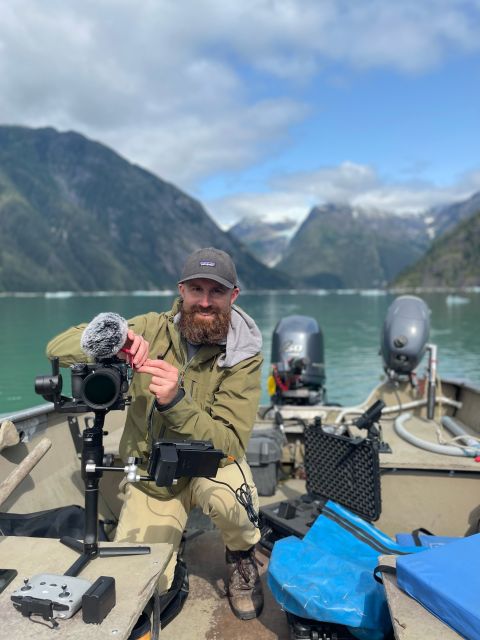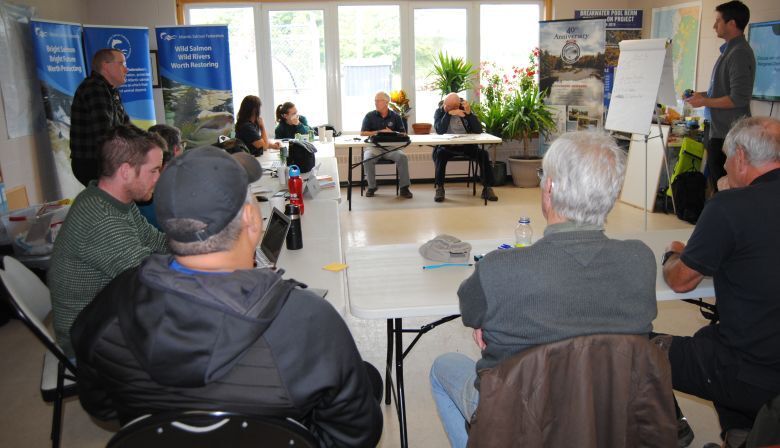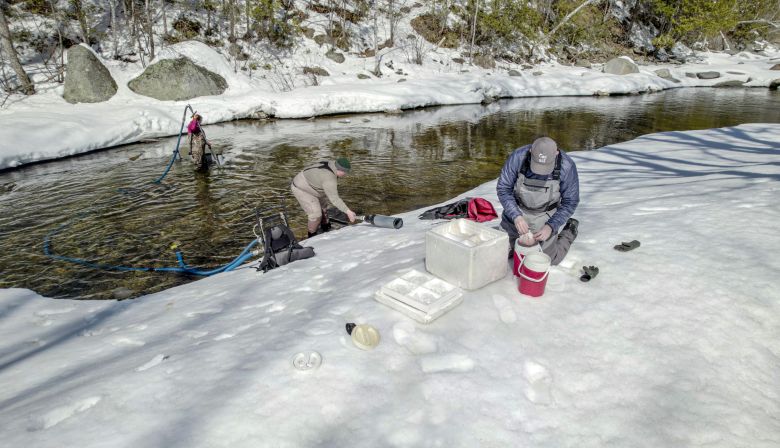
Subscribe & stay up-to-date with ASF


“Rivers flow not past, but through us, thrilling, tingling, vibrating every fiber and cell of the substance of our bodies, making them glide and sing. The trees wave and the flowers bloom in our bodies as well as our souls, and every bird song, wind song, and tremendous storm song of the rocks in the heart of the mountains is our song, our very own, and sings our love.” – John Muir
Hello, Rivernotes readers! My name is Peter Dore, and I’m honored to be your new editor. Having been a part of ASF for the past year, I’ve come to love reading and contributing to this blog. Like many of you, during fishing season, I eagerly anticipate the release of each new edition of Rivernotes. The passion and dedication of the people in the Atlantic salmon conservation community is captivating, and I’m humbled to now be a part of this family.
Rivernotes is special. It’s an annual repository for the stories, knowledge and experiences of our passionate Atlantic salmon conservation and angling collective. Without the dedication and hard work of this community, this blog can’t exist. The stories, insights, and perspectives shared here are a testament to the commitment and expertise of those who care deeply about the health and well-being of our cherished fish. As the new editor of Rivernotes, I am thrilled to have the opportunity to share your messages and amplify your voices.
Growing up in Maine’s western mountains instilled in me an enthusiasm for all things wild. More recently I have worked in Alaska’s Tongass National Forest, lived in Lake Tahoe, California, and toured Canada’s Maritime provinces. The ineffable beauty, immense power, and innate sacredness of our rivers and mountains are at the very core of my being. Whether exploring local streams or traveling to remote destinations, I have witnessed the incredible diversity of these natural wonders and the need to protect them for future generations. I’m excited to share this passion for conservation, fly fishing, and our environment with you.
Learning, sharing, and action; this is what Rivernotes is all about. Together, through Rivernotes, our collective attention to the numerous issues facing wild Atlantic salmon and their habitat can make a real difference in preserving our rivers, their surroundings, and the amazing, biodiverse wildlife that calls these places home.
“Rivers flow not past, but through us, tingling, vibrating, exciting every cell and fiber in our bodies, making them sing and glide.” Let’s celebrate the power and beauty of these natural wonders.
Thank you for reading, and I look forward to sharing more with and hearing from you soon!
Kind regards,
Peter Dore


Serge Collin is coming to us with over 20 years of experience in marketing and sales, travel media, community development, and project management in the municipal and provincial tourism sectors.
Members of the angling community will know Serge from his role in the provincial department of Tourism, Heritage and Culture. There, he served as lead for development and marketing of the fishing and hunting sector, building relationships with travel media, industry stakeholders, outfitters, associations, and communities.
The Richibucto native lives on the Acadian Peninsula on the Island of Lamèque, where he and his wife Chantal have raised their two children, Marc-André and Marie-Michelle.
Serge is proud of his Acadian heritage, and loves to discover different regional accents—and recipes. An avid outdoorsperson, he spends most of his time on the river or on the trails, regularly participating in activities such as fly fishing, fly tying, hunting, camping, canoeing, snowmobiling, and the list goes on. So basically, Serge can be found either in the great outdoors or in a kitchen (his or someone else’s), usually among friends and family.
“I’ve been fortunate to have a career where I’ve worked with amazing people, blending work with my passions; either through community and economic development, or through tourism, promoting this wonderful province,” Serge told Rivernotes.
You can reach Serge at scollin@asf.ca.

NS Program Director, Deirdre Green writes:
Once again, many rivers did not have the benefit of a true spring freshet this year. Kicking off the season in low water conditions has become an unwelcome trend in Nova Scotia. This has some anglers concerned about our coldwater species and the angling season ahead, but the community remains optimistic rain will come.
Meanwhile, anglers throughout the province are excitedly sharing their adventures and fish tales. The muddy riverbanks now showcase the footsteps of those who ventured out early and what a joy to see even more youth and women out.
Fishing was decent in Guysborough County for sea-run brook trout migrating out to estuaries. However, Antigonish and Pictou County rivers didn’t produce as well as expected. Many people have been angling by boat in the estuaries, where they’re noticing more striped bass, but very few baitfish and smelt.

In the Halifax area anglers were greeted with cold temperatures hovering around 1-3 degrees Celsius. The mayfly hatch came slightly early and was thick. The trout opener tradition of bushwhacking and paddling provides a much-needed reprieve from the winter doldrums. And despite the windy, cool conditions, many beautiful trout were hooked by those who know where to go. Water is now up to 13-14 degrees C and hatches are prevalent.

As readers will recall, Hurricane Fiona brought a lot of debris into rivers last year. Over winter, things moved about and settled. This caused notable changes in the lower Margaree River on Cape Breton Island.
Tagging adult and juvenile salmon through the multi-year DFO-led program to understand how Atlantic Salmon are using the Labrador Sea has wrapped up in Nova Scotia. DFO research scientist Martha Hiscock Robertson recently shared the tagging summary for 2021 and 2022 (see below). It’s no surprise to see healthy results from the St. Mary’s River, an outlier on Nova Scotia’s Atlantic coast.

Scott Beaver, President of the St. Mary’s River Association, had this to say: “Absolutely right, there’s salmon in this river. There’s salmon all through this river.”
DFO stopped counting adult salmon on the St. Mary’s as part of budget-cuts during the Harper era. Yet the number of fish being captured for tagging and observed by locals puts the St. Mary’s leaps and bounds ahead of others. With arguably the largest population of salmon in mainland Nova Scotia, the St. Mary’s should be a DFO priority for adult salmon assessments.

Looking down at my cluttered desk—the masses of flies and debris accumulated from a winter’s worth of preparation—my mind hums with anticipation for the 2023 angling season. The idea of picking up where we left off is ringing loud. 2022 was a big year: a bump in returning fish, conservation efforts, and an increase in young, motived anglers. It’s inspired me to fight harder and louder this season. Atop of the list is a push to encourage others to continue to lead by example.



Nathan Wilbur, Executive Director of Regional Programs, reports from New Brunswick
It was a mixed bag of conditions in New Brunswick on opening day of the spring salmon fishing season, April 15. Some rivers had been free flowing for weeks, while others had just experienced their ice run, and some in northern NB were still locked up with ice.
Anglers dodged ice chunks in their boats on the Southwest Miramichi, but with a few warm days the ice flushed out and conditions improved for the second week of the season.
Anglers reported that hook-ups greatly improved with the warmer weather with kelts leaving the bogans and making their way downriver. Through the winter, fly tying scratches the itch, but by all accounts, people were very happy to get back out on the water and smell the dirt again


ASF’s Newfoundland and Labrador program director Don Ivany filed this report:
This past winter was a fairly mild one in NL, and there was far less snow than usual this year throughout the province. Spring, on the other hand was cooler than usual, resulting in slower snow melt than usual. As such, there is still some snow on the high country on the island of NL, but in lower elevation areas most snow is now gone.
However, the situation is very different in Labrador. In fact, as of April 29th, people in southern Labrador were still snowmobiling and ice fishing, and there is still a couple of feet of ice on many ponds in that area.
All this suggests that by the time the angling season for salmon opens on the island of NL (June 1st) we could see low water levels and warmer than normal water temperatures, especially given we’ve had very little rain to date and daily air temperatures are now in the low teens. By the time the season opens in Labrador (June 15th), we will likely see high water levels and cold water temperatures.
Weather patterns can also have an effect on marine sea survival of salmon. For example, there is a correlation between marine sea survival of salmon and sea ice conditions in the Labrador Sea. During years when sea ice conditions are heavy, sea survival is often lower. Due to a milder winter in Labrador this year, sea ice conditions were moderate at best. So, all things being even, marine sea survival might be a little better this year, meaning more fish surviving to make it back to our rivers.
By the way, if you are an iceberg enthusiast, the mild winter also resulted in more ice calving from ice shelf disintegration, which is why we have seen record numbers of icebergs flowing down through the Labrador Sea this year and along the northeast coast of the island.
Given that 2023, is the second year of a two-year recreational salmon management plan, the regulations this year will be exactly the same as what they were in 2022. Details on the 2022-2023 Salmon Management Plan can be found in the Anglers Guide on DFO’s website at the following link: https://www.nfl.dfo-mpo.gc.ca/…. In general, the maximum retention level for the season will be two salmon, with a maximum of one salmon on Class 2 Rivers. Note, all large salmon greater than 63 cm must be released on all rivers in Newfoundland and Labrador. Retention of salmon on non-scheduled rivers is not permitted. The daily limit for catch and release is three salmon. Environmental protocols used in 2022 will also carry over to the 2023 season (please see the link to the anglers guide above for specific details of the plan).
As we begin to gear up for the opening of the recreational salmon season in NL, we encourage all anglers to keep conservation of the resource at the forefront by: follow the rules and regulations, report all poaching activity, pack out what you pack in, keep the fish in the water at all times when practicing live release, and always adhere to good angling etiquette.
Tight lines!

Kris Hunter takes us inside his journey to establish ASF’s new freshwater program
About one year ago I agreed to take on the job of establishing the Wild Salmon Watersheds program, an ambitious network of Atlantic salmon watersheds across the healthier portion of species’ range. Its goal is to create safe havens to preserve existing populations while also sowing the seeds of recovery. This exciting program will ensure wild salmon and the environment on which they depend will flourish for generations to come.
Since taking on this role I’ve spent a lot of time on the road, crisscrossing Eastern Canada developing the program, engaging potential partners, and establishing three pilot projects led by outstanding local Indigenous and non-Indigenous partners.

These pilots—the Nepisiguit watershed in N.B., the Margaree and Cheticamp in N.S., and the Terra Nova in N.L.—are led by local advocates who are now identifying what is working and what can be improved in their watersheds. They’ll then work towards creating effective protections and fostering stewardship.
More recently, my travels have shifted to meeting with potential collaborators who can help with things like watershed mapping and climate change modelling.

ASF’s John Burrows reports:
Despite the colder than normal weather, the first alewives (gaspereau) began showing up in Maine’s rivers during the last week of April and we are all anxiously awaiting the first salmon of the season.
The early migration ground to a halt with last weekend’s rain storms, which dumped as much as 6 inches in parts of the state. Dozens of road culverts washed out, demonstrating the importance of having adequately-sized road-stream crossings not only for fish passage, but also for public safety and climate resilience.
Our larger rivers are now slowly receding and hopefully the great spring sea-run fish migration will recommence in earnest next week. Will our first salmon show-up on the Penobscot or Narraguagus this year? Or will it be the Kennebec? Stay tuned


The fish lift at Milford on the Penobscot River was opened 4/24/2023.
River herring count/estimate is currently 364
River temperature has ranged from 7.7 to 10C. A few river herring have shown up as well as a few other species. River flows are still high. As flows decrease and temperature increase we expect the herring run to increase rapidly.
More next week!!


Sure enough, Paul Christman did that. And he succeeded. Starting by planting eggs in old refrigerators buried in the snow next to the Sandy River—an idea that was abandoned after a season or two in favour of a backpack-mounted pump that could plant fertilized eggs directly in the gravel—Paul pioneered a restoration technique that has literally brought the Kennebec River watershed back to life for salmon. Salmon were all but extirpated from the Kennebec, and crazy as the idea was, a rag-tag group of volunteers from ASF, TU, and other conservation-minded groups have put Paul’s idea to work.

Donning snowshoes over waders and wading boots, hauling a pump, coolers full of incubating eggs, and a stack of metal cones for planting eggs, and setting out by snowmobile and then on foot to remote parts of the Sandy River and its tributaries, a team of people are now helping Paul plant more than a million eggs per year.
Small beginnings, and still just a fraction of the 6 million eggs it would take to fill the Sandy River’s high quality spawning habitat, but the program is working. A smolt trap mark-and-recapture study in 2021 and 2022 showed that the smolt run from the Sandy River—which had not seen an Atlantic salmon for more than 150 years—is now the largest in the US (not counting stocked smolts). And 2023’s adult salmon return of 82 salmon is the largest return to the Kennebec in modern time.

